
The following is a verbatim copy of a report that appeared in The Standard ,Wednesday , October 1944 . Though the article is dated 1944 , thankfully incidents appear to tail off in 1942 .
WAR ORDEAL OF SKEGNESS
387 ALERTS , 39 INCIDENTS and 144 BOMBS .
It has frequently been asserted- with complete truth-that Skegness has much to be thankful for in respect of its experiences throughout enemy action . On the other hand there have been 39 incidents when bombs were actually dropped ; and the statistics which follow in this article amply reveal that the resort also had many thankful escapes
It shared in addition the experience of many other coastal towns and villages in the shape of unnerving and mournful happenings the “incidents” here-under recorded do not , however , constitute a true yardstick by which the emotions of residents can be measured throughout the 5 years of War . During those nerve wracking winters of 1940 – 41 – 40 . the siren wailed out in the early evening and the “all clear” was often not sounded until well into the following morning .
Many hundreds of enemy bombers passed over with the towns to discharge their loads on other districts inland . Heavy detonations frequently shut doors and windows and created anxious speculation as to what was happening at a more or less incalculable distance away.
And who among the population is there who did not listen with a fast-beating heart to the single raiders which detached themselves from the main force or followed at an interval and “zoomed” over and around the town , as though searching out a target ?
The unspoken query in hundreds of minds was : “Is Skegness for it tonight ?” and prayers of relief and thankfulness were uttered when at last , the noise of the engines gradually died away and anxious listeners felt that the immediate danger at any rate had passed .
Those emotional experiences will never be erased from the memory of town people .
144 bombs dropped
The alert has been sounded at Skegness 387 times and as stated above 39 incidents have occurred when bombs were actually dropped . A total of 144 high explosive bombs came down , of which 127 fell in the urban district and 17 on a holiday camp in the near vicinity of the resort.
The weight of the bombs dropped was approximately 18 tons of which two and a half tons fell on the camp referred to , in the course of 4 incidents . It is quite impossible to form any accurate estimate of the number of incendiary bombs which fell , in addition to these high explosives .
The number of fatal casualties was 36 of which 16 were civilians ; and 181 persons received injuries of which civilians numbered 61 .
Happily a considerable percentage of these injuries were of a more or less minor nature and most of the victims in the latter category made a speedy and good recovery .
At this juncture it is fitting to pay deserved tribute to the manner in which the various Civil Defence services responded to calls and carried out their allotted tasks . Isolated points of criticism are almost inevitable in emergency undertakings of this kind but generally every branch of service concerned , emerge with honour and warm appreciation of their work , but by those persons directly concerned in incidents and the public has a whole .
For security reasons it has hitherto been impossible to pay a similar tribute to Services personnel which were quartered in the town at the relevant periods . This tribute is now unhesitatingly paid and will be warmly subscribed to buy all civil defence workers with whom the services personnel cooperated in the humane activities .
THE FIRST BOMBS
The first bombs to fall on Skegness were the old type incendiaries , three of these being dropped on the Seacroft golf course about 1:15 a.m. on July 23rd 1940 . The first experience of high explosive bombs came at 12:45 midnight on August 19th 1940 , when four were dropped , again on the Seacroft golf course . They caused no damage and no casualties.
Two days later on August 21st , townspeople have their first really exciting War experience.
Enemy machines came over at 12:35 midday and dropped five high explosive bombs in the grounds of the National Deposit Society’s Home and Castleton Boulevard. One of these fell on the pavement close to the County Hotel but the latter did not even sustain a broken window ! A gas main was set on fire but generally the damage done was very small. British fighters appeared and there was machine gun fire over the town and out to sea and as one of the bombers faded on the horizon , a dull red glow was seen in it , suggesting that it was on fire.
While sightseers congregated near the County Hotel and were watching the repair parties at work about 1.10 the same day , another plane was noticed coming from the direction of Burgh and the shout went up ; “It’s a Jerry!” . As people dashed for the shelter , many of them saw this machine release a string of bombs , which it was feared would fall right on the centre of the town .
Happily however , most of them fell in fields south of Richmond Drive , although two fell near the end house (next to the old football field) and damaged it considerably. Water gas and sewerage mains were also damaged.
Twenty bombs fell and a little later the same day , five bombs were dropped on a holiday camp , doing some damage and killing three persons and injuring 38 others. Those 30 bombs within a very short space of time constitutes the most concentrated bombing experience the town has undergone.
GERMAN CLAIM
About 3:10 a.m. on August 23rd 1940 , bombs fell on properties in Park Avenue and Glentworth Crescent and on North Parade , near the Pier.
Two little children lost their lives and 5 persons received injuries . Four houses were destroyed and others had subsequently to be pulled down while the general damage to properties was very considerable, as also was to the mains of public services.
Among a number of unnerving experience is Mrs G. H. Allen who was living alone in her house in Glentworth Crescent, woke to find herself in bed with the greater part of her house blown away.
The local A.R.P. Chief also had an unenviable experience. A high official in the Warden’s service who lives in Park Avenue, saw a gap where a house had formerly stood, and promptly ran all the way to the Control Centre to report this . While the A.R.P. Chief was making his way to the spot in the pitch darkness , he found himself in a huge crater full of foul smelling sewage and literally had to swim across it in order to reach what was left of Mrs Allen’s house.
The following day the Germans broadcast that they had bombed industrial works at Skegness and Yarmouth during the night !
Subsequently visitations up to the end of 1940 are given below in chronological order :
August 25th 1940 at 8:15 p.m.- Single bomb dropped in Castleton Crescent, damaging the fabric of several houses. An amusing incident was connected with this ; a ventilator pipe being mistaken for a bomb sticking out of the ground by one of the “investigators”.
August 28th 1940 9:56 p.m. – Single bomb dropped on foreshore near Seacroft golf course. No damage.
August 29th 1940. midnight. – Two “screaming” bombs fell in a field near the Royal Oak Hotel. These were the first bombs with a whistling attachment to be reported. No damage.
September 2nd 1940 9:20 p.m. – Unknown number of incendiary bombs of the old type dropped at the far end of the Seacroft golf course.
October 3rd 1940 at 4 p.m. – 4 cwts of bombs dropped at the back of Alexandra Road (Cattle Market and Messrs. Pattinson’s premises ). Three persons were injured. Damage to properties fairly extensive.
October 3rd 1940 at 4:15 p.m. – Twelve bombs dropped on Holiday camp. No damage whatsoever.
October 9th 1940 at 11:30. – Junkers 88 chased out to sea by 5 spitfires and shot down into the water.
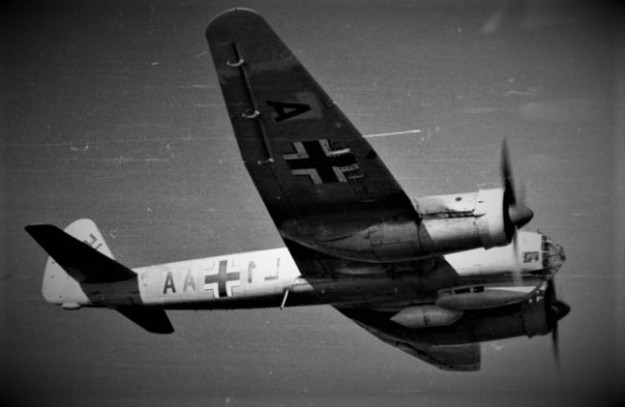
November the 7th 1940 at 8:37 p.m. – Number of incendiaries fall in Mr Cook’s field off Wainfleet Road and near vicinity and were put out by N. F. S. without doing any damage.
November 14th 1940 at 2:10 p.m. – Three high explosives fell on the beach opposite Princes Parade, causing extensive window and ceiling damage in houses on South Parade and further afield . one bomb failed to explode.
November 23rd 1940 at 7:20 p.m. – Large number of incendiaries dropped in the Burgh Road and Seathorne district. Some of these burnt the grass verge near North Foreland Drive. An unknown passenger dismounted from a bus and extinguished some of the bombs burning his hand in helping.

THE 1941 LIST.
January 2nd 1941 at 6:48 p.m. – Several incendiaries fell on the foreshore at the end of Albert Avenue , Seacroft. No damage.
January 18th 1941 at 4 p.m. – An experience to Lumley Road residents in particular will vividly recall. It was a snowy afternoon and several shop windows in the main thoroughfare were lighted up. A single radar flying low came in from the West and dropped a string of 14 bombs on premises at the east end of the thoroughfare and in the Tower Esplanade. Well known professional man and councillor Mr Kenrick Morgan died later from injuries received and Mr. Charles Hershberg , a cafe proprietor was killed by flying glass. Other persons were injured and the damage done was very considerable.
Some 300 children were at a matinee in the Tower Theatre which was hit by 1 bomb but thanks to splendid work by servicemen and others , the children were got out without injury .
An account of the bombing by Basil T Shillaker who was 15 at the time. (Image courtesy of Jane Shillaker).
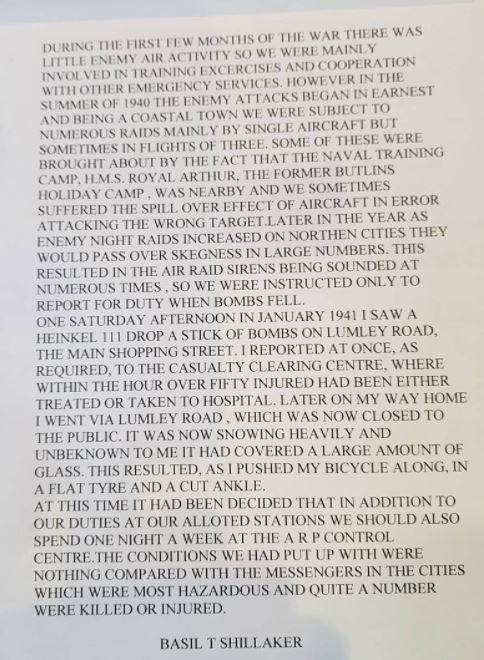
Skegness Clock Tower and Tower Theatre .
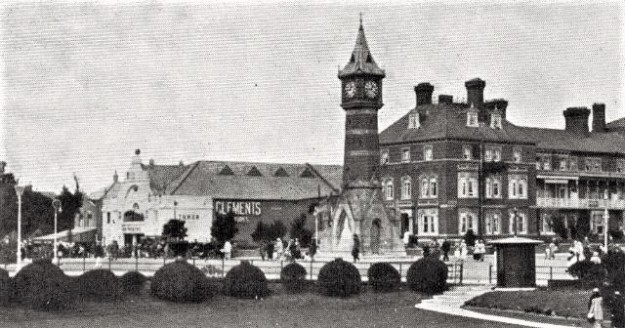
February 16th 1941 at 2 a.m. – Three bombs were dropped in Algitha Road , one severely damaging the Methodist Church and the other two , rendered unsafe two large semi-detached houses a few yards from the church. A fire watcher on the roof of Messrs. Marks and Spencer’s premises gave the control centre the first news that bombs had fallen.
An extraordinary feature was that a fireman who lives opposite the church did not hear the bombs nor did several soldiers who were billeted in the two houses referred to when they were awakened , they were covered with soot.
February 16th 1941 at 2:50 a.m. – One bomb fell on the Holiday Camp without doing damage . A little earlier the same night seven high explosives fell in the field at the back of Richmond Farm , Winthorpe , making big craters but doing no damage.
February 17th 1941 at midday – In very misty weather single radar machine-gunned the Holiday Camp and dropped 13 heavy bombs . One person was killed and 3 injured.
March the 13th 1941 at 9:50 p.m. – an enemy plane was shot down into the sea off Skegness.
March the 14th 1941 at 10:50 p.m. Incendiaries were scattered over various parts of the town without doing any damage worth mentioning. They were put out by wardens and NFS men. Within 20 minutes of dropping the bombs the machine was shot down into the sea in flames.
March 15th 1941 at 1 a.m. – Seven bombs fell in the brickyard, Burgh Road, doing no damage.
April 7th 1941 at 11:52 p.m. – Another nasty experience for Skegness. Eight bombs damaged the church hall, police station, flats in Lincoln Road, a platform on the railway station etc. The Church Hall was being used as a First-Aid Party depot. It was at first feared that several casualties might have occurred. Happily , however , the bomb struck the further End of the building and although terribly shaken , up the first-aid personnel escaped without injury. They responded to other calls straight away. Dr M. Backwell who was hurrying to the scene , met two policeman whose faces were covered in what appeared to be blood.
It was found to be red ink a bottle which was shattered when the police station was hit! Damage was heavy but there were no casualties.
May 8th 1941 at 12:45 midnight. – One heavy bomb was dropped in a field near Winthorpe Grange, making colossal crater.
May 10th 1941 at 3:56 a.m. – Eight bombs fell in Saxby avenue. One small boy was killed and damage to property was extensive.
May 12th 1941 at 1:50 a.m.- One bomb fell on Seacroft golf course doing no damage.
June 14th 1941 at 3 a.m. – Seven bombs dropped on and around Dean’s farm on Wainfleet Road, farmhouse was practically demolished. One man was killed and two persons injured. Service mains and roadway were damaged.
July 6th 1941 at 2:50 a.m. – Three bombs fell on beach near Derbyshire Miners Home at Seathorne. No damage.
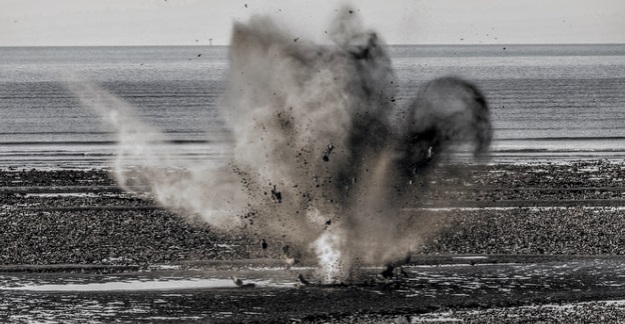
July 9th 1941 at 2:48 a.m. – Three more bombs dropped at the same spot as above with similar results.
July 9th 1941 at 2:50 a.m – . Bomb weighing nearly a tong dropped on the beach at Gibraltar Point.
August 8th 1941 at 6.05 p.m. – Enemy Plane machine-gunned the Seathorne area but no casualties were caused or damage done.
August 15th 1941 at 3:45 a.m. – Ten bombs fell in the Coronation Walk and Vine Walk and almost up to the railway line but no damage resulted.
October 13th 1941 at 12:15 midnight. – String of 8 bombs dropped in and near the boating lake. One fell in centre of lake which had to be emptied and repaired and another on the edge of it damage to windows was sustained.
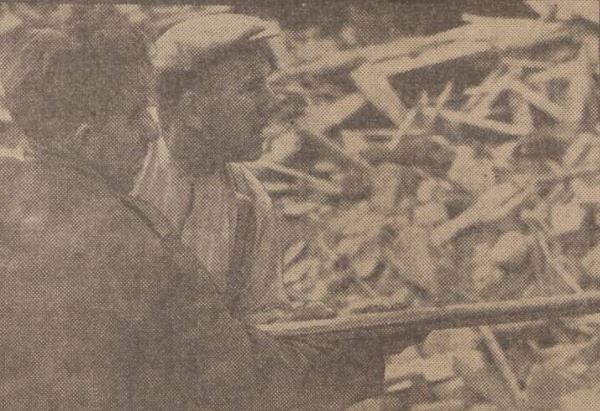
1942 EXPERIENCES.
7 incidents marked the year 1942 , the last , which also proved to be the worst of the war occurred on October 24th.
February 2nd 1942 at 1:38 p.m. – Two bombs fell in the National Deposit Home grounds. A gas-lamp was flung from the North Parade almost to the Waterway. People on the parades had narrow escapes, and in one case an army N.C.O. saved two service girls from almost certain death or injury. a third large bomb fell on the North Parade Sports Ground. Civil service’s personnel and others who were lunching in Mrs Blanchard’s cafe under the Pier so the bomb hit the ground and waited for the explosion. It didn’t come , the bombs failing to explode and were they thankful !
February 21st 1942 at 10 a.m. – Two bombs fell in Norwood Road and Vine Road , Seacroft . One house got a direct hit but fortunately the occupants were out at the time . The bomb failed to explode and many months elapsed before it could be located and retrieved, the house having to be demolished in the process. Other properties were severely damaged as was also the electricity main.
February 21st 1942 at 10.08 a.m. – Probably the same plane flew on to the holiday camp and dropped bombs, four person’s being killed and 14 injured.
July 27th 1942 at 7:36. – In dull and drizzling weather a raider came in low from the sea and dropped four bombs on properties in Lumley Avenue North. There were seven fatal casualties among these being a mother and daughter in the same house. Twenty-three persons were also injured . Damage to property on an extensive scale.
After a request , these are further reports from local papers a few days after, of this tragic incident:
“…….An N.C.O. In the Home guard,
who was going to business, had a
narrow escape, a machine gun bul-
let luckily ricochetting the right
way so far as he was concerned.
RESIDENTIAL AREA BOMBED.
The bombs fell in a residential
area in the near vicinity of a
boulevard road, demolishing some
houses and severely damaging a
number of others.
Unhappily, five fatal casualties
resulted, three of these being in
one house. They were Mrs. Ada
Mary Shaw, her daughter, Miss
Florence Lilian Shaw, and the
former’s married sister, Mrs. Helen
Maria Ball. Yet another member
of the family, Miss Maisie Shaw,
received injury, necessitating hos-
pital treatment. Another daughter
was away on holiday at the time.
In a house near by, Mrs. Gertrude Chadwick, an elderly lady,
was killed in sight of her husband,while carrying in a cup of tea; and
the fifth victim was Mrs. Laura Kirk (58), whose husband was
among the injured.
Twelve persons were officially
posted as injured, these being: Mrs.
Botham, Master Ronald Botham,
Miss M. Shaw, Miss Donoghue,
Miss Hewitt, Mrs. N. Ayres, Mr.
Albert White, Mrs. S. Frankiss,
Mrs. Rodger, Mr. Henry Kirk, Mrs.
C. Storr, and Mr. P. Shaw. Some
of the foregoing were on a visit to
the town and were staying at the
houses in which they received in-
jury.
BRITISH SPIRIT.
One bomb which hit the corner
of a house ricochetted off the
pavement into a house opposite. As
usual, too, many curious effects of
the blast from bombs were noted.
A number of persons had narrow
escapes from death or serious in-
jury.
One lady who was lying in bed
wearing her spectacles had the
latter shattered by a flying
fragment of glass, but her face was unmarked….
The funerals of four of the victims as reported :……
Mrs. G. CHADWICK.
The funeral tock place on Friday
of Mrs. Gertrude Chadwick, aged
68, of “Stella Maris”, Lumley
Avenue, whose death occurred
very suddenly on the Monday previous.
The deceased lady was the
wife of Mr. Sam J. Chadwick, who
was formerly in business at Ilkeston for many years prior to settling
down in retirement at Skegness over 15 years ago.
Both Mrs. Chadwick and her husband were held in
great respect by all who knew
them, and the tragically sudden
death of the former evoked great
sympathy with the bereaved bus-
band.
Father C. B. Croucher conducted
the funeral service at the Roman
Catholic Church, and was assisted
by Father T. Nunn, of Boston, and
Squadron-Leader Father Prescott,
of the R.A.F. The remains were
interred in St. Clement’s Church-
yard. Mr. Chadwick was too ill
to attend the funeral, and the
principal mourners were Mr. and
Mrs. T. W. Chadwick (son and
daughter-in-law), and Captain and
Mrs. Fletcher (son-in-law
and daughter).
The funeral arrangements were
carried out by Messrs. F. Wood and
Sons, Prince George Street.
MRS. LAURA KIRK.
Mrs. Laura Kirk, of 63, Lumley
Avenue, Skegness, who died in the
Cottage Hospital following severe
injuries received the previous Mon-
day, was buried in St. Clement’s
Churchyard on Friday last, The
service and interment were con-
ducted by the Rev. J. Lyth, B.A.
Mrs. Kirk, who was 56, was the
wife of Mr. Henry Kirk, who is
very well-known among the
gardening fraternity locally in his
capacity as vice-chairman of the
Chrysanthemum Society and mem-
ber of the War-time Horticultural
Committee. A chrysanthemum
grower of many years’ standing,
The Standard , AUGUST 5 1942
DOUBLE FUNERAL
Skegness Family’s Sad
Ordeal
THE funeral of a mother and
daughter whose deaths occurred very tragically the previous
Monday, took place on Thursday
in St. Clement’s Churchyard, the
Rev. W. F. Willson, B.A., conducting the obsequies.
The deceased ladies were Mrs.
Ada Mary Shaw (58), and Miss
Florence Lilian Shaw (27), of 8,
Lumley Crescent, Skegness. The
former was a native of the resort,
being the second daughter of the
late Mr. “Jack” Moody. of High
Street, whose long connection with
the lifeboat (of which he was cox-
swain for some years) and other
seafaring activities are well re.
membered by the older class of
resident .
Mr. E. Shaw, the bereaved
husband and father, is a foreman
joiner and has been in the employ
of Messrs. George Dunkley and
Son for something like 40 years.
Miss Shaw was employed at a naval
training camp.
The chief mourners were as fol-
low, the relationship given in
parenthesis being that to the elder
lady: Mr. E. Shaw (husband);
Mr.and Mrs. Duffin (son-in-law and
daughter), Sleaford; Miss Kathleen
Shaw (daughter), Skegness; Mr.
C. E. Shaw (son), Skegness; Miss
M. A. Shaw (sister-in-law), Toyn-
ton. near Spilsby; Sergt. J.
Mitchell (nephew), Scunthorpe;
Mrs. Goulding (niece), Notting.
ham; Mr. and Mrs. J. Porter, Skeg-
nes ; Mr. and Mrs. S. T. Porter,
Skegness.
Mr. H. Shaw, the
younger son, is serving in the Navy
and was unable to be present, as
also was another daughter, Miss
Maisie Shaw, who is in hospital.
A TRAGIC NIGHT
September 15th 1942 at midnight. – A large number of incendiaries fell around the Arcadia Theatre, causing a few small fires which were soon put out. Two heavy bombs were also dropped, one demolishing , with a direct hit , a large house which was being utilised by a local solicitor as his offices. The other fell near the clock tower, making a huge crater and dislocating gas and other services. and an incendiary container was also dropped on a house in Grand Parade, causing 3 deaths. The cutting off of the water supply in the area greatly hindered firefighting operations.
September 15th 1942 midnight – Several of a then new type of incendiary , termed “flower pots” were dropped near Gibraltar Point without doing any damage.
Photo of a shored-up house in Park Avenue , Skegness after the 1942 raid .
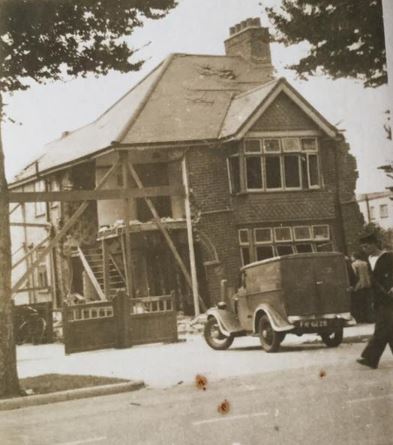
October 24th 1942 at 9:45 p.m. – One of the worst incidents of the war. A bomb of large size fell on property at the junction of Park Avenue , Scarborough Avenue and seven of the “flower pots” were also dropped.
Twelve persons lost their lives and no fewer than 68 received injuries . Some ten houses including large boarding establishments were demolished and over 300 damaged. Another house was set on fire and had to be subsequently pulled down. A tragic night for many families.
Did space permit , the foregoing could be amplified very considerably , particular the major incidents. The chronological sequence will bear out however , introductory assertion that Skegness has had its share of attention from enemy aircraft and yet withal has a lot to be thankful for. Had not a large percentage of the bombs fallen on open ground , a very much sadder tale would have to be told. Incidentally, in order to nullify any argument which may arise, we would like to make it clear that the times are approximate, although substantially correct.
* Photos used not necessarily Skegness unless labelled .
Link to Mablethorpe war damage :
Link to Spilsby and Wainfleet war damage .
I’m trying to find out more information on the bombing in Skegness July 27th 1942, can anyone help with this
Thanks for your comment . Because news reports were censored and often didn’t give precise locations it’s difficult to get information . Apart from this from above I’m not sure if there is any other info ……….. “four bombs on properties in Lumley Avenue North. There were seven fatal casualties among these being a mother and daughter in the same house. Twenty-three persons were also injured”. I will have a further look and report back if I find anything .
Naanbread , I have found a further report of the damage of 27th July 1942 together with reports of two of the victims funerals and added it to the text for that date above . Hope this helps .
This is fantastic that you have found so much information. I am still unsure if its the correct bombing I’m looking for as yet. Is there a way to contact you directly to discuss?
Naanbread , sorry we will have to stick to messaging via this blog . Too many spammers about , to go posting email addresses on here .